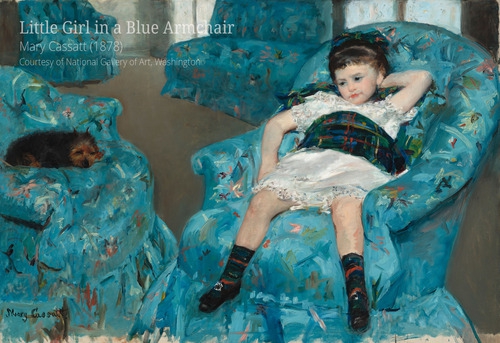Mary Cassatt: A Woman's World

Originally from Pittsburg, Pennsylvania, after many travels throughout Europe, she finally settled in Paris in 1874, in time for the first impressionist exhibition. Cassatt accepted the invitation of her close friend Edgar Degas and exhibited for the first time with them in the fourth show of the group in 1879. From then on she showed work in all other shows of the group until 1886.
One of the paintings she showed in her first impressionist show was Little Girl in a Blue Armchair (1878). A little girl is sprawled in a big armchair in the living room of her family’s apartment. She looks tired and bored and gazes absentminded to the right where we see a lapdog. Her clothes are quite fashionable for the time, with the tartan belt and socks matching, her hair is also carefully arranged. However, for all the hard work of her nanny, the way she sits destroys the doll like appearance she was supposed to give. It is an act of rebellion from the part of the girl; should an adult see her she will be told to sit proper. In this way Cassatt gives a new image of childhood. A child that seems out of place in this big living room and feels constraint in the social norms of the adult world. In essence it is a realistic image of a child and not of a child behaving like a little adult, as was the norm for centuries.
It is no wonder that a woman painted such a subject. The nursery was a space occupied predominately by women. Indeed Cassatt portrayed children or the subject of motherhood many times. As a woman, she was not allowed to wonder in the streets or frequent cafes to capture the spirit of modern times that the male impressionists showed in their paintings. So she painted a woman’s world.

Another aspect of that world were the social interactions at the theatre. In the painting The Loge (1880) we see two young women at a theatre box. They seem to be absorbed in the performance below. Nonetheless, as we can see from the other boxes and the lit chandelier, the two women are aware that they are seen and therefore, they are very self conscious. One hides behind her fan while the other holds her bouquet firmly. She tries to assume as neutral an expression as possible so that none can be privy to her feelings. In this case the two women know the social norms of the time and respond accordingly to it.
Therefore, Mary Cassatt manages to present to us in these two paintings the female universe of her time: the private, domestic environment, where the scene with the little girl takes place and more freedom is allowed, as well as the public space of the theatre, where everyone, especially young ladies, have to abide by the rules.
Anastasia Manioudaki is an Art Historian with an MA in Art History from the University of Sussex and a BA in Archaeology & History of Art. Anastasia is currently lecturing on art history and a contributing author for USEUM.